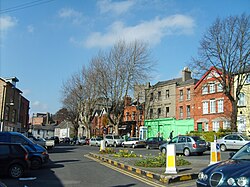Chapelizod
| Chapelizod Irish: Séipéal Iosóid | |
| County Dublin | |
|---|---|
 Chapelizod village | |
| Location | |
| Grid reference: | O236249 |
| Location: | 53°20’49"N, 6°20’42"W |
| Data | |
| Population: | 3,056 (2016) |
| Post town: | Dublin |
| Postcode: | D20 |
| Local Government | |
| Council: | Dublin |
Chapelizod is a village of County Dublin, preserved as such though now surrounded by the townscape spread out from the city of Dublin. The village stands in the wooded valley of the River Liffey, near the Strawberry Beds and the Phoenix Park. The village is associated with Iseult of Ireland and the location of Iseult's chapel.
It is within the Baony of Castleknock.
The village takes its name from being the Chapel if Iseult (which in Irish is rendered Séipéal Iosóid.
History
The origins of Chapelizod are obscure. There is evidence of Neolithic settlement between the southern ridge of the Phoenix Park and the Liffey and several burial mounds exist to the north of the village. Aerial photography has also revealed several prehistoric and early mediæval settlements in the vicinity of the modern village. Aside from these archaeological remains, the etymology of the village indicates an association with Princess Iseult/Isolde from the Arthurian legend of Tristan and Isolde, and the village derives its name from a chapel consecrated in her honour.
Outside the archaeological and mythical record, the historical record more firmly details the establishment of a manor by Hugh Tyrell after the Anglo-Norman invasion of 1169. In 1177, Tyrell, Baron of Castleknock, granted lands at Kilmainham to the Knights Hospitallers. The grant included a portion of the land that now makes up the Phoenix Park and Chapelizod. After the Dissolution of the Monasteries, the lands reverted to the Crown and from that time onward were used as a Royal seat. This was made explicit by the Duke of Ormonde after he successfully lobbied for the creation of an enclosed deer park outside Dublin in 1662. The 'King's House', a Royal Residence built by and used as an out of town residence by the Viceroy, formerly faced the millrace on the banks of the Liffey. It was used as the royal residence in Ireland until the mid-eighteenth century, when the Viceregal Lodge was completed in the Phoenix Park.
In 1671, Colonel Richard Lawrence settled a number of Hugenots in the village with the intention of establishing a linen industry (with some success). Later, King William III stayed during the reconquest war in Ireland, holding court and redressing grievances.
During much of the eighteenth and nineteenth centuries, Chapelizod was a prosperous village with a rural atmosphere close to the centre of Dublin.
About the village
Interesting buildings in the village include:
- The Church of St Laurence (Church of Ireland) with its mediæval bell tower.
- The well-proportioned Georgian house, where Joseph Sheridan Le Fanu once resided in his early childhood, stands at the corner of Park Lane facing Main Street in front of the church.[1]
- The old Royal Irish Constabulary barracks on Main Street, now refurbished, which predates the foundation of the Constabulary, serving as an army barracks from the reign of William and Mary.
Events
Chapelizod Community Festival is held annually between the first and second Sundays in July. First held in 1994, the festival has grown to be one of the highlights of the summer here. The festival is run by volunteers and funded mainly by local business sponsors.
In literature
The village is the setting of Le Fanu's novel The House by the Churchyard and short story Ghost Stories of Chapelizod.
In James Joyce's short story "A Painful Case", published in Dubliners, it is the home of the unsociable protagonist James Duffy, who "lived in Chapelizod because he wished to live as far as possible from the city of which he was a citizen and because he found all the other suburbs of Dublin mean, modern and pretentious." It is the setting—as well as the scene of the home and hostelry of the protagonist Humphrey Chimpden Earwicker, his wife Anna Livia Plurabelle, and their family Shaun, Shem and Issy—in Joyce's final major work, Finnegans Wake.
Sport
- Cricket: Chapelizod Cricket Club[2]
The Chapelizod Sports Stadium hosted greyhound racing (1949-1961) and speedway (1950-1961).[3]
References
- ↑ FUSIO. "34 Main Street, Chapelizod, CHAPELIZOD, Dublin 20, Dublin City" (in en-GB). https://www.buildingsofireland.ie/buildings-search/building/50060308/34-main-street-chapelizod-chapelizod-dublin-20-dublin-city. Retrieved 2020-10-28.
- ↑ Chapelizod Cricket Club
- ↑ "Chapelizod". Irish Independent/Press Reader. https://www.pressreader.com/.